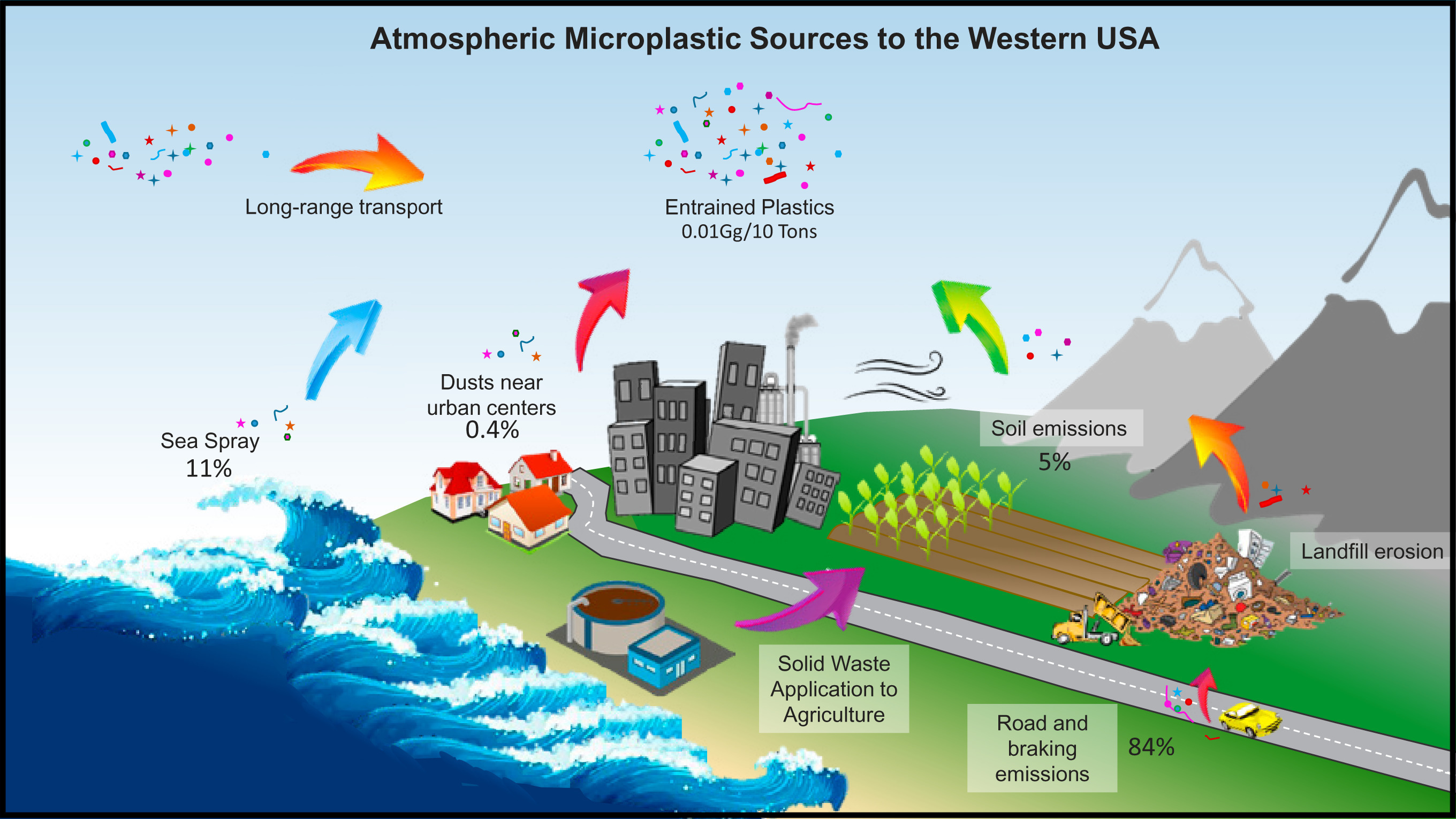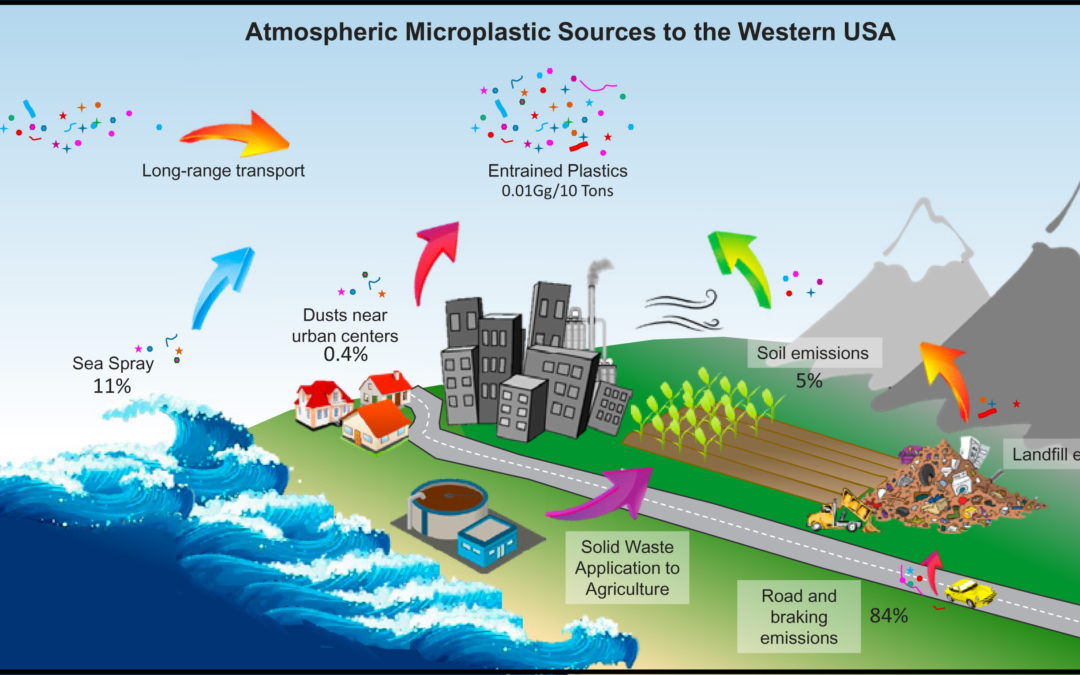Plastic has become an obvious pollutant over recent decades, choking turtles and seabirds, clogging up our landfills and waterways. But in just the past few years, a less-obvious problem has emerged. Researchers are starting to get concerned about how tiny bits of plastic in the air, lofted into the skies from seafoam bubbles or spinning tires on the highway, might potentially change our future climate.
“Here’s something that people just didn’t think about — another aspect of plastic pollution,” says environmental analytical chemist Denise Mitrano of ETH Zürich University, in Switzerland, who co-wrote an article last November highlighting what researchers know — and don’t yet know — about how plastics can change clouds, potentially altering temperature and rainfall patterns.
Clouds form when water or ice condenses on “seeds” in the air: usually tiny particles of dust, salt, sand, soot, or other material thrown up by burning fossil fuels, forest fires, cooking, or volcanoes. There are plenty of these fine particles, or aerosols, in the skies — a lot more since the Industrial Revolution — and they affect everything from the quality of the air we breath, to the color of sunsets, to the number and type of clouds in our skies.
Until recently, when chemists thought of the gunk in our air, plastics did not leap to mind. Concentrations were low, they thought, and plastic is often designed to be water repellent for applications like bags or clothing, which presumably made them unlikely to seed cloud droplets. But in recent years, studies have confirmed not only that microscopic pieces of plastic can seed clouds — sometimes powerfully — but they also travel thousands of miles from their source. And there are a lot more particles in the air than scientists originally thought. All this has opened researchers’ eyes to their potential contribution to atmospheric murk — and, possibly, to future climate change.
“The people who invented plastics all those decades ago, who were very proud of inventions that transformed society in many ways — I doubt they envisaged that plastics were going to end up floating around in the atmosphere and potentially influencing the global climate system,” says Laura Revell, an atmospheric scientist at the University of Canterbury in New Zealand. “We are still learning what the impacts are for humans, ecosystems, and climate. But certainly, from what we know so far, it doesn’t look good.”
Global annual production of plastics has skyrocketed from 2 million tons in 1950 to more than 450 million tons today. And despite growing concerns about this waste accumulating in the environment, production is ramping up rather than slowing down — some oil companies are building up their plastic production capacity as the demand for fossil fuel declines. To date, more than 9 billion tons of plastic has been produced, and about half of it has gone to landfills or been otherwise discarded. Some project that by 2025, 11 billion tons of plastic will have accumulated in the environment.
Plastic has been found in soils, water, crops, and on the ocean floor. And in recent years, several studies have suggested that microplastics (pieces less than 5 millimeters in length) and nanoplastics (smaller than approximately 1,000 nanometers) were being transported long distances through the air. In 2019, for example, researchers found microplastics in the Pyrenees that had arrived via rain or snowfall. In 2020, Janice Brahney of Utah State University and four coauthors published a high-profile Science paper revealing high amounts of plastic in federally protected areas of the United States. Brahney had found the plastic by accident; she had been looking for phosphorus, but was surprised by all the colorful bits of gunk in her ground-based filters. Her study led to a slew of headlines warning, “It’s raining plastic.”
Brahney’s extensive U.S. dataset also opened the door for modelers to figure out where, exactly, all this plastic was coming from. “It’s a really beautiful data set,” says Cornell University’s Natalie Mahowald, who did the modeling work.
Mahowald took the plastic concentrations Brahney had cataloged and mapped them against atmospheric patterns and known sources of plastics, including roads, agricultural dust, and oceans. On roadways, tires and brakes hurl microplastics into the air. Plastic winds up in agricultural dust, notes Mahowald, in part from plastics used on farm fields and in part because people toss fleece clothing into washing machines: the wastewater flows to treatment plants that separate solids from liquids, and about half the resulting biosolids get sent to farms for use as fertilizer. As for the ocean, Mahowald says, big globs of plastic in places like the Pacific Gyre degrade into microscopic pieces, which then float to the surface and are whipped up into the air by chopping waters and bursting air bubbles.
Plastic bits are now found in human lungs. “We’re definitely breathing them right now,” says a scientist.
Mahowald’s model concluded that over the western U.S., 84 percent of microplastics were coming from roads, 5 percent from agricultural dust, and 11 percent from the oceans. Plastic is so lightweight that even chunks tens of micrometers across — the width of a human hair — can be lofted and blown great distances. The model revealed that some of this plastic was found thousands of miles from its presumed source. The smaller the pieces, the longer they can stay aloft.
While individual bits of plastic may stay in the air for only hours, days, or weeks, there’s so much being kicked up so consistently that there’s always some in the air: enough that plastic bits are now also found in human lungs. “We’re definitely breathing them right now,” says Mahowald.
Working out exactly how much plastic is in our skies is extremely difficult. Most of these studies are done by painstakingly teasing bits of plastic out of filters and examining them under a microscope to get an estimate of shape and color, then using spectroscopic techniques to confirm their source material. The smaller the pieces, the harder they are to identify. Studies can also be plagued by contamination: walking into a lab wearing a fleece sweater, for example, can skew results with shedding plastic microfibers.
Nearly a dozen studies have shown airborne microplastic concentrations ranging from between 0.01 particles per cubic meter over the western Pacific Ocean to several thousand particles per cubic meter in London and Beijing. The cities showing higher levels are probably genuinely more polluted, says Revell, but it’s also true that those studies used a more-sensitive technique that could identify smaller bits of plastic (under 10 micrometers in size). The other studies would have missed such smaller pieces, which made up about half the plastic found in the London and Beijing studies.
In the lab, preliminary tests show that battered plastic pieces can be potent cloudmakers.
Concentrations of airborne nanoplastics are understood even less. The numbers floating around today, says atmospheric chemist Zamin Kanji, Mitrano’s colleague at ETH Zürich, are likely to be “significantly underestimated.”
For now, the proportion of plastics to total airborne aerosols is tiny, so plastics aren’t contributing much to aerosol climate impacts, says Mahowald. Even in London and Beijing, plastic may account for only a millionth of the total aerosols. But plastic production, and the accumulation of plastic in the environment, keeps going up. Says Mahowald, “It’s only going to get worse.”
That’s especially true in less polluted regions — like over the oceans of the Southern Hemisphere, Kanji says. Since plastic can likely travel farther than other, denser aerosols, it could become a dominant airborne pollutant in more pristine areas. Brahney and Mahowald’s paper concludes that plastic currently makes up less than 1 percent of anthropogenic aerosols landing on the ground but they could, “alarmingly,” make up more than 50 percent of the aerosols landing on some parts of the ocean downwind from plastic sources.
Exactly how aerosols affect climate has been a critical sticking point in climate models, and many of the details are still unknown. Different aerosols can change the climate by either reflecting or absorbing sunlight, which can depend, in part, on their color. Black soot, for example, tends to have a warming effect, while salt reflects and cools. Aerosols can land on the ground and change the albedo, or reflectivity, of ice and snow.
Aerosols also affect cloud formation: different bits and pieces can seed more and smaller droplets of water or ice, making for different types of clouds at different elevations that last for different amounts of time. High-altitude, thin, icy clouds tend to warm the Earth’s surface like a blanket, while low-altitude, bright and fluffy clouds tend to reflect sunlight and cool the Earth.
Though tiny, aerosols have an oversized influence on climate. The murk of anthropogenic aerosols in the sky has, overall, had a dramatic cooling effect since the Industrial Revolution (without them, global warming would be 30 to 50 percent greater than it is today). And they have more sway on extreme weather than greenhouse gases do: a world warmed by removing aerosols would have more floods and droughts, for example, than a world warmed the same amount by CO2.
Revell and her colleagues took a stab at trying to model how microplastics might affect temperature by either reflecting or absorbing sunlight, a calculation of what’s known as “radiative forcing.” For simplicity’s sake, they assumed that plastic is always clear, even though that’s not true (and darker material tends to absorb more sunlight), and that the global concentration is uniformly one particle per cubic meter, which is on the order of 1,000 times lower than concentrations measured in, say, London.
With those assumptions, Revell found that plastic’s direct impact on radiative forcing is “so small as to be insignificant.” But, importantly, if concentrations reach 100 particles per cubic meter (which they already have in many spots), plastics could have about the same magnitude of radiative forcing as some aerosols already included in Intergovernmental Panel on Climate Change assessments. In other words, plastics become noteworthy. But whether they would warm, or cool, the Earth is unknown.

Aerosols often have a greater impact on the climate through their influence on clouds. Pristine plastic beads, Kanji notes, repel water and so are unlikely to affect clouds. But plastic can “age” in a matter of hours, says Kanji, during its transit to the sky: it can be abraded, or it can accumulate salt from the ocean and other chemicals from the atmosphere, all of which can make the particles more water-loving. Plastic pieces can also contain nooks and crannies, which aid in the formation of ice.
In the lab, Kanji’s student Omar Girlanda has run preliminary tests showing that under such battered conditions, plastic pieces can be potent cloudmakers. “Some of them are as good as mineral dust particles,” says Kanji, “which is the most well-known, effective ice nucleus out there.”
Kanji says skies heavily polluted with plastic will probably make both more high-altitude ice clouds, which tend to warm the Earth’s surface, and more low-altitude water clouds, which tend to cool the Earth. Which effect will dominate is unknown. “It doesn’t make sense to model it at the moment, given the poor estimates we have of [atmospheric] plastic,” says Kanji. Plastic could also affect precipitation patterns: in general, Kanji says, clouds that are more polluted tend to last longer before bursting into rain than do less polluted clouds, and then they rain more heavily.
Revell and her colleagues are now whittling down the assumptions in their paper, working out more detailed calculations for more realistic estimates of plastic concentrations, colors, and sizes. “All we know is that the problem is not going to go away anytime soon,” she says. “These plastics are incredibly long lived. They’re breaking down, and they’re going to be forming new microplastics for centuries. We just don’t know how big the problem is that we’ve committed ourselves to.”
If you’d like to read the original source of this article please click here Visit Source

